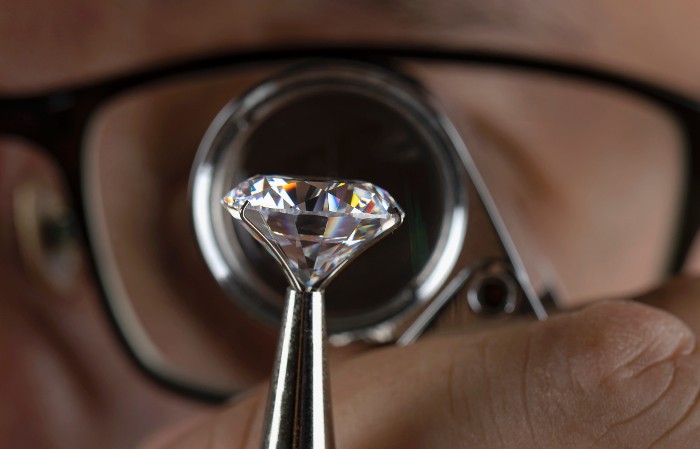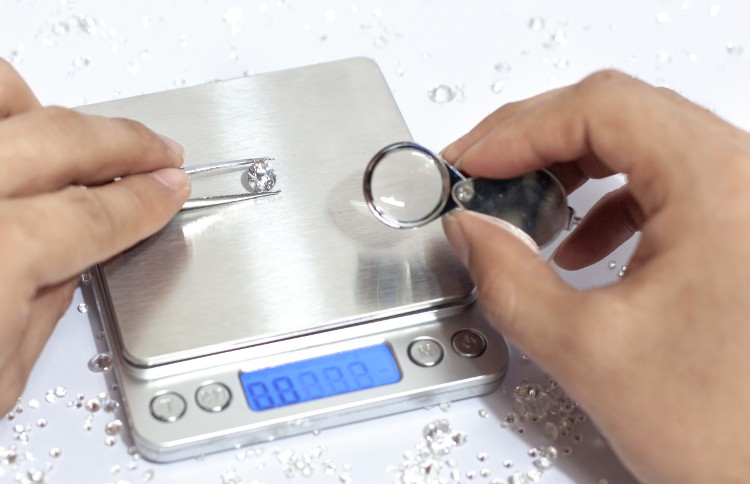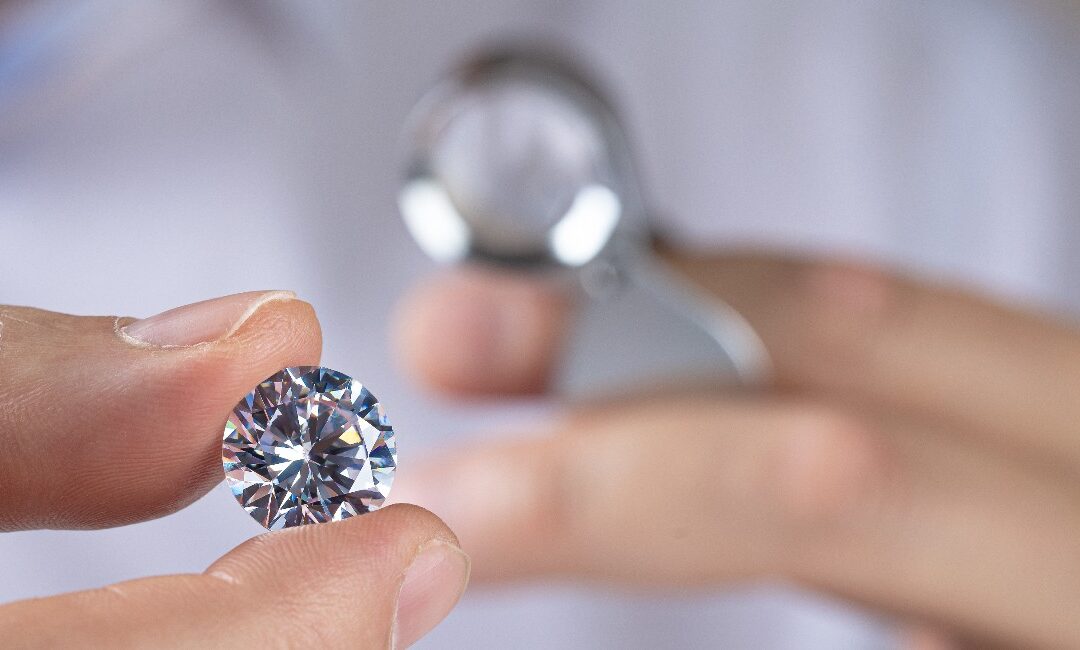Scratching Test
When it comes to determining whether the diamonds are real or not, the scratching test is a tried and true method. Using a tool with a hardness level close to that of a diamond (typically a steel file), lightly scratch the surface of the suspected diamond. If there is no visible damage or scratches left behind, it is likely to be a real diamond. However, if the surface appears scratched or scraped, it may not be a genuine diamond. It’s important to note that this test alone isn’t enough to completely prove authenticity; for stricter verification, it’s best to consult a professional gemologist or take the stone to a reputable jewelry store for advice. In any case, the scratching test can provide helpful insight when trying to determine if a diamond is real or not.

The Protractor Method
Authenticating diamonds can be a tricky process, but the Protractor Method is a useful tool in determining if a diamond is real. First, the diamond is placed on a protractor with its bottom flat against the base line. Then, a pen or pencil is placed on top of the diamond and slowly dragged across the gemstone’s surface. If the pen or pencil skips or catches on any part of the diamond’s surface, it is likely a fake. However, if it smoothly glides across without any snags, it is likely to be genuine. It’s important to note that this method isn’t fool-proof as there are certain types of fake diamonds that can pass, but it’s still an effective technique for initial assessments before moving onto more advanced methods of authentication. Overall, the Protractor Method can be a helpful tool in evaluating the legitimacy of diamonds.
Test For Its Strength
Another way to tell whether a diamond is real is by testing its hardness. As the hardest known natural substance on earth, diamonds are not able to be scratched or chipped with any tool other than another diamond. A hammer, for example, will not leave a mark on a real diamond. However, it’s important to note that hardness alone cannot definitively prove a diamond’s authenticity. Other tests, such as checking for flaws under magnification or conducting a thermal conductivity test, can also help determine if a diamond is genuine. Ultimately, consulting with a professional gemologist is the best way to confirm the authenticity of a diamond.
Heat Test
As anyone who has purchased a diamond knows, it’s important to be sure that the gem is genuine. Fortunately, there is a simple test that can help analyze if a diamond is real or fake: the heat test. By heating up the diamond and then placing it on a cold surface, like an ice cube, genuine diamonds will cool very quickly while fake ones will remain warm or even become hotter. Of course, it’s important to use caution when conducting this test, as it could potentially damage any gemstone – not just diamonds. It is best to seek professional assistance to properly and safely conduct a heat test. In any case, being able to conduct this test can provide peace of mind in knowing that your diamond is the real deal.

Feel The Weight Of The Diamond
When determining a diamond’s authenticity, the stone’s weight and size can often be a useful indicator. Due to their high density and molecular structure, diamonds tend to be much heavier than other gemstones with a similar appearance. When compared to a fake diamond of similar measurements, a real diamond will feel significantly heavier in the hand. Additionally, diamonds have an extremely high refractive index, meaning they are able to bend light in unique ways that can easily distinguish them from faux gems. However, when it comes to accurately identifying a diamond’s legitimacy, it is best to consult with a professional who has the necessary equipment and expertise. So while feeling the weight of the stone may offer initial insight into its authenticity, it should not be considered a definitive method.
Water Test
When it comes to purchasing diamonds, it’s important to make sure they are the real deal. One way to distinguish genuine diamonds from imitations is by conducting a water test. To perform this test, fill a glass with water and drop the diamond in. If the diamond sinks, it is likely to be real. This is because diamonds have a high density, causing them to sink quickly in liquid. Imitations made of materials such as quartz or glass, on the other hand, will not have the same density and will float or only slightly sink. Remember that this is not a foolproof method, as some imitations may have a similar density to diamonds. However, the water test can still provide valuable insight when determining the authenticity of a gemstone. Always consult with an expert for a definitive answer especially if you are in the market to sell diamonds.
Fog Test
When purchasing a diamond, it’s important to ensure you’re getting the real deal. Luckily, a simple test can help determine a diamond’s authenticity: the fog test. First, hold the diamond and fog it in a way you would do to a mirror. If the fog dissipates quickly, the diamond is likely real. Fake diamonds will hold onto the fog for longer periods of time due to their lower thermal conductivity. Of course, this test is not foolproof and should not be the only method of assessment. It’s also important to consult with professionals and ask for certification documents before making any big purchases. However, the fog test can be a helpful tool in determining if a diamond is genuine or not.
Sparkle Test
The Sparkle Test is a simple, effective method for determining the authenticity of a diamond. With a loupe or magnifying glass, examine the stone and look for reflections in the form of small arrows. Real diamonds will have distinct, perfectly symmetrical arrows within the facets, while fake diamonds may exhibit hazy or asymmetrical reflections. Be sure to perform the test in a well-lit environment, as dim light can make it difficult to accurately assess the reflections. It’s important to note that this test does not guarantee the authenticity of a diamond, but it can provide valuable information for making an informed purchasing decision. As with any important investment, seeking the guidance of a trained professional is always recommended.
Magnification Test
When it comes to assessing the truth about diamonds, the magnification test is a reliable tool. This test involves using a jeweler’s loupe, a small magnifying device, to examine the stone and look for specific characteristics. Real diamonds have inclusions, tiny flaws inside the stone that can be seen under magnification. Fake diamonds, such as cubic zirconia, will often appear smooth under the loupe because they are created in a lab rather than formed naturally in Earth’s crust. In addition, real diamonds will typically have rounded edges due to their crystalline structure, while fake diamonds usually have sharper edges because machines cut them. The magnification test can also be used to confirm a diamond’s cut and clarity grade. Overall, this simple yet powerful tool can provide key insights when determining if a diamond is real or not.
Check for A Diamond Certificate
When it comes to purchasing a diamond, it’s important to make sure that you’re getting a true and valuable stone. One way to ensure this is by asking for a diamond certificate from the seller. These certificates, typically issued by independent gemological labs, provide an in-depth analysis of the diamond including its dimensions, cut, clarity, and carat weight. They also often include a specific identification number that can be used to know and verify whether the diamond is true or not. While purchasing a certified diamond may involve some additional cost, it ultimately offers peace of mind knowing that your investment is legitimate. So before buying your next piece of jewelry with diamonds, don’t forget to ask for a certification. It could mean the difference between real and fake.
Use A diamond Tester
When purchasing diamonds, it is important to ensure that they are genuine. But how can you tell the difference between a real diamond and a convincing fake? One tool to help with this process is a diamond tester. These devices measure a stone’s thermal conductivity, as diamonds are excellent conductors of heat while most imitations are not. However, it is necessary to note that these testers cannot distinguish between different types of genuine diamonds, so be sure to also use other methods such as checking the stone’s cut and clarity. Overall, using a combination of techniques including a diamond tester can help guarantee that your diamonds are authentic.
Laser Inscription Test
Many people are familiar with the traditional methods for determining if a diamond is real, such as checking for flattened edges or using a diamond tester. However, one lesser known technique is laser inscription testing. This process involves inscribing a microscopic number or symbol onto the diamond using a laser, in order to create an identifier for the stone. This number is laser inscribed on the stone after officially getting certified. This number can be used to confirm the diamond’s authenticity through an official database that anyone can check online. In addition to verifying that a diamond is real, laser inscription testing can also be used as proof of ownership and to provide further details about the stone, such as where it was sourced from or its carat weight. Overall, laser inscription test offers another level of assurance when it comes to identifying genuine diamonds.
Consult An Expert
When it comes to diamonds, it’s important to know exactly what you’re getting. Even a trained eye can be fooled by subtle differences in cut, clarity, and color, not to mention the proliferation of synthetic diamonds in the market. That’s why consulting a certified gemologist is crucial in determining the authenticity of your diamond. Gemologists have specialized training and equipment that allows them to examine a diamond under different lighting conditions and magnifications. They are also able to use thermal conductivity tests and other methods to determine whether a diamond is genuine or not. So before making any major investments in diamonds, make sure to consult with an expert first. It’s better to be safe than sorry when it comes to such a valuable commodity.
So, these were some ways of checking if a diamond is real or fake. If you’re still doubtful about the authenticity of your stone, then it’s time to take it to a professional. At Diamond Exchange Online, we have a team of experienced jewelers who can help you with anything related to diamonds – from buying and selling to appraisals and jewelry consignment. Schedule an appointment with us today, and we will be more than happy to assist you further.


